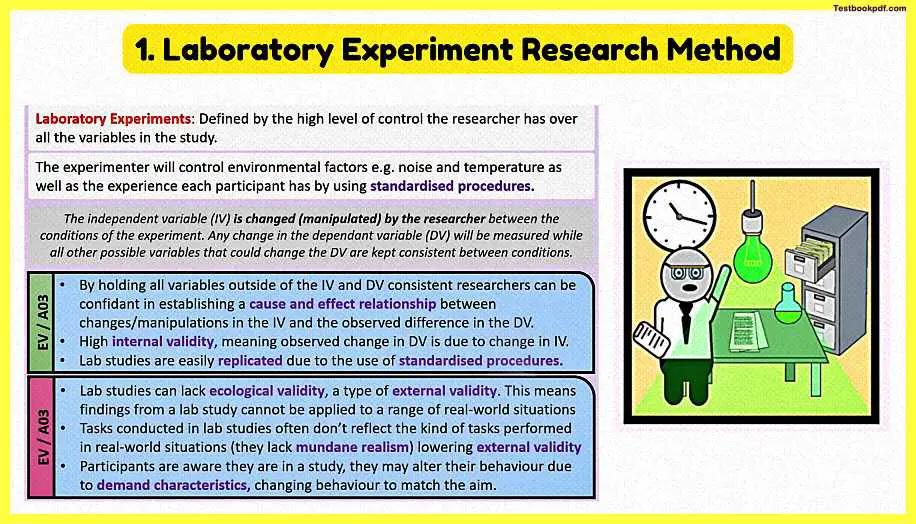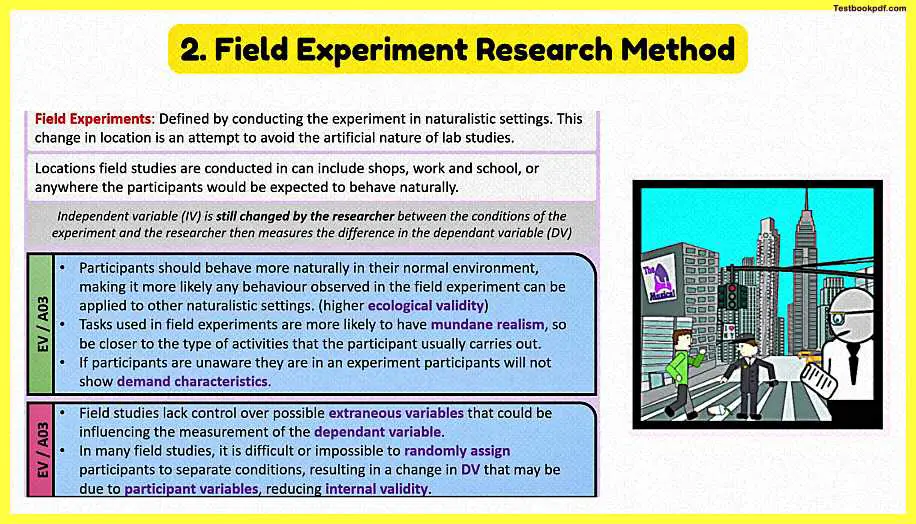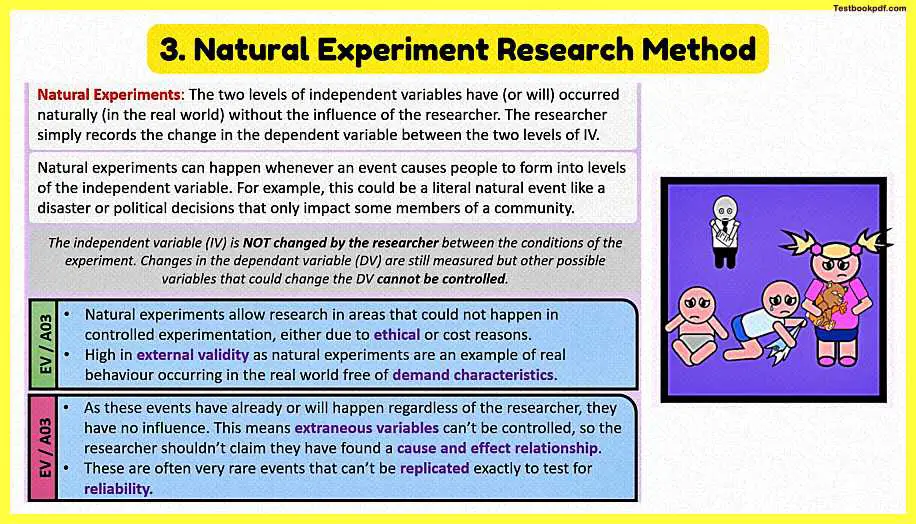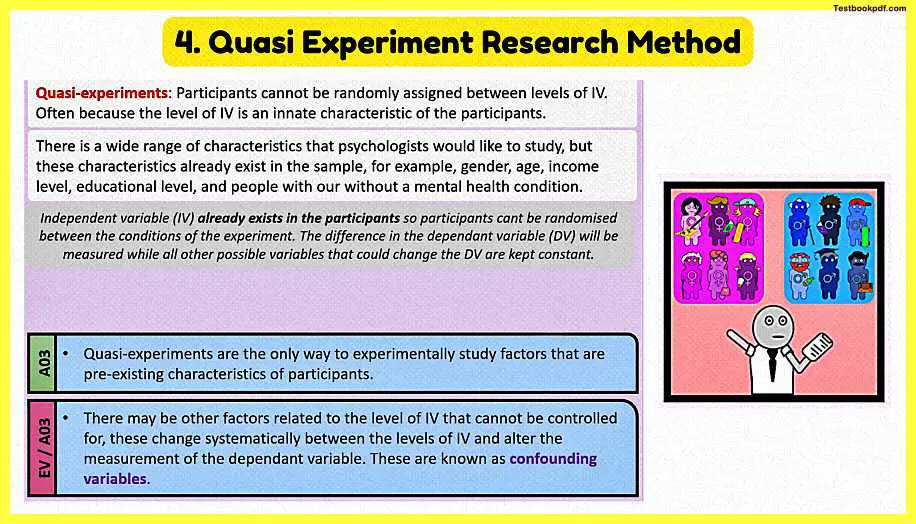List of All Types of Experimental Research Methods Pdf Download (Psychology)
Today in this article we will talk about almost All Types of Experimental Research Methods Pdf Download and we will discuss the different types of experiments like Lab, Field, Natural, and Quasi Experiments, and discuss the strengths and weaknesses of each. If this is your first time coming to research methods, you’re going to hear lots of terminologies that you don’t know. This can be a little intimidating, but the more you hear these words and their definitions, the more confident you will get with research methods.
1. Laboratory Experiment Research Method

The first type of laboratory or “lab” experiment is probably familiar to you. A lab experiment could literally be set in a laboratory, but the important principle here is the experimenter has full control over what happens in the experiment. Environmental factors, like noise, temperature, and even the instructions given to the participants are all highly controlled and don’t vary between conditions, we call these factors variables. In a lab experiment, the experimenter tries to make sure only one factor of the experiment, called the independent variable changes between the conditions, and all other variables are kept the same. This is so the experimenter can then measure how changing this independent variable changes the variable measured known as the dependent variable.
For example, we may want to investigate how changing the color of light in the room, but not anything else influences the recall of numbers. An advantage of using a lab experiment is by controlling for all other variables, you can be confident in suggesting a cause-and-effect relationship. Because you kept everything else constant, the variation you made to the independent variable caused the change measured in the dependent variable. This high control over the experiment means we would argue that lab experiments have high internal validity, what they have measured is true. The observed effect is real and is due to the change in the independent variable, not some other, uncontrolled factor.
Lab experiments are also highly replicable, you can give the instructions to another researcher, so a list of standardized procedures for the participants and variables to keep the same. Then if the researchers can conduct it in the same way and get the same results your confidence in the validity of your findings increases.
However, there are disadvantages, Lab experiments may lack external validity, the laboratory is not like the real world, and behaviors observed in lab conditions may not generalize to environments outside of the lab, like the home, school, or work this is known as lacking ecological validity. Also, the tasks used in an experiment are often unusual, not like tasks used in the real world and so the behavior may not be the same in the real world, this is known as lacking mundane realism. Also being set in a lab, participants are aware they are in an experiment, they know the experimenter wants to find something out, and are likely to change their behavior to match what they think is expected from them. If this happens you would say your study suffers from demand characteristics.
2. Field Experiment Research Method

Field experiments attempt to fix some of the weaknesses of Lab studies. So instead of being set in a lab, they are conducted in the real world.
For example, the natural setting of shopping centers, places of work, or schools. Places where people are used to behaving naturally. The strengths of doing field experiments are increased external validity, people would be expected to show more naturalistic behavior in their natural environment, so we can be confident in generalizing any behaviors measured to other situations, meaning higher ecological validity. Also, tasks used are more likely to be real-world tasks, meaning increased mundane realism. If the participants are unaware that they are taking part in a study, which is easier in a field experiment, demand characteristics are also not a problem.
However, the weaknesses of field experiments are due to the lack of control we had in the lab experiment. The real world is chaotic, and in a field experiment we are not able to control every possible variable that may change your measurement of the dependent variable, these are known as extraneous variables, and often in a field study researchers are not able to randomly assign the participants to each condition. This means that any effect observed may be due to a factor other than the change in the independent variable. This reduces the internal validity of the experiment.
3. Natural Experiment Research Method

In the previous two types of experiments, the researcher manipulates the independent variable themselves and then records the change in the dependent variable.
However, in a natural experiment, the levels of the independent variable have already happened naturally the researcher just measures the change in the dependent variable.
For example, let’s imagine you wanted to study what would happen to children’s development if you stopped them from getting any love and affection very early in life, say you wanted to compare a group that had been deprived of love for less than six months, a group between 6 months and two years and a group that had no emotional care for over two years. Then they are put with caring families. Well of course you could never actually conduct this as a lab experiment for ethical reasons. But this did happen to children in Romania in the 1980s and a researcher called Rutter followed these children up as they grew and recorded the effect of this deprivation on their development.
The strengths of natural experiments are they allow research in areas that could never be done otherwise, either due to ethical reasons like Rutter, or cost. Also, natural experiments are very high in external validity, these changes have happened naturally in real life and would have happened with or without the researcher, so any changes in behavior can’t be the result of demand characteristics.
However, as the researcher has no control over the experiment, like randomizing participants to groups, or controlling for extraneous variables, there may be other factors that have influenced the dependent variable, meaning we are not as sure of a cause and effect relationship between the IV and DV as we are in a lab study. Also because these situations occur naturally and are often rare, these studies can’t be replicated to see if we get the same results.
4. Quasi Experiment Research Method

Quasi the final type of experiment is known as a quasi-experiment, it has an unusual name, but it’s simple. In a true experiment, you should be able to randomly assign participants to the different levels of the independent variable. So blue light or green light on recall. But there are lots of studies we would like to conduct in which people can’t be randomly assigned between conditions.
For example, if we are studying gender, age, or the differences between people with or without a mental health condition. These groups already exist and if we can’t as a researcher assign people to the different conditions, or manipulate the levels of IV, that is a quasi-experiment. A strength of this type of experiment is it’s simply the only way to study these factors. But a negative is there could be differences in these groups that go beyond group membership.
For example, if we are conducting a study on males and females, and looking at puzzle solving. There may be differences in how males and females have been educated and socialized that explain the results. These factors that change systematically between the conditions and can’t be controlled are known as confounding variables.
Thanks For Reading this Article, Share it with your Friends.
Read also:
Psychology Research Method Experiment Variables Pdf Download
Erik Erikson Stages of Development (8 Stages+Theory+Images)
Piaget Theory Of Cognitive Development Pdf Download Complete



